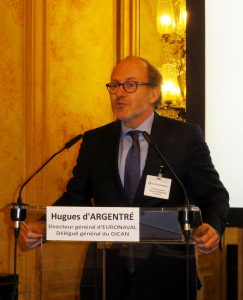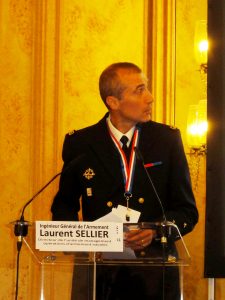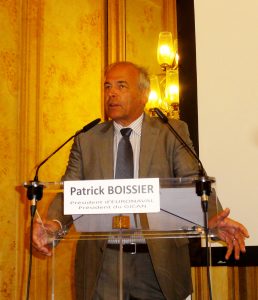Euronaval 2016 : a good vintage in view
By Jean-Michel Guhl
The 25th venue of the French naval exhibition Euronaval, due to be held in Paris-Le Bourget next this 17 to 21 October, is already set to be one of the most exciting ever for the many expected international visitors, such has this military event become one of the world’s most important naval shows. Despite the fact that the French capital has none of the sea shores or portuary facilities of a natural harbour, like Singapore, Mumbai, London, Abu Dhabi or else., it remains an international reference due to the fact that it usually is a gathering point for most if not all the key players of the globe’s military naval industry. And after all, the heraldic emblem of Paris is a boat !

Currently experiencing a renewed vitality, in the wake of new maritime tensions arousing in Australasia, in the Indian ocean and in the Gulf region, the military naval industry has gone through a very fast and major growth, all this because of China.
One of the first beneficiaries of this move is France whose defence industry, particularly in the aeronautical and naval fields, have bagged many important contracts over the past months. The latest being a huge contract with Australia in order to develop twelve advanced conventional propulsion oceanic attack submarines for the Royal Australian Navy, the Shortfin Barracuda Mk.1 directly derived from the nuclear-powered Suffren-class SSN.
For its 25th edition, Euronaval 2016 has already attained its planned objectives with a growth rate of 10% compared to the 2014 edition.

A positive international context
Military naval construction is not doing too badly. This industrial sector being less sensitive to the global economic crisis than civil construction, which itself needs to be considered sector by sector. Certain sectors such as cruise ship construction are experiencing a period of growing order demand. Military naval construction and security is directly dependent on the evolution of international relations and global security levels. At this time when the risk of terrorism is added to regional tensions and territorial and economic revindications at sea, a number of maritime countries are legitimately choosing to strengthen their navy’s equipment economic maritimisation and international trade are also accompanied by an increased need for surveillance and protection of exclusive economic zones, of shipping routes and coastal or port zones.
Maritime states are thus confronted with an imperative need to reinforce their assets in terms of naval surveillance. There is also the need to invest funds to equip themselves with blue water navies, with air-sea surveillance and intervention capacities and increasingly often with submarines. It has become clear that the number of submarines has substantially increased across the world in the last few years, as shown by the many contracts signed since then.

A 30 to 40 billion dollar yearly market
On a global scale, the military naval sector alone represents around 40 billion dollars, corresponding to deliveries of defence vessels. The American market is stable and remains the largest, with approximately 12 billion dollars per year. This is followed by India, Australia and the Far East, all on the rise, with figures close to 12 billion dollars, not including future submarine contracts. The China‐Russia block is showing strong growth and represents some 8 billion dollars of investments each year. Development of export and competition export markets are consequently growing too. From the Asia‐Pacific zone, the American continent and the Middle East through to Africa, order prospects are very strong, from heavily armed large warships to small fast patrol boats, covering the whole range of surface and submarine naval capacities as well as maritime surveillance.
While export has long been the prerogative of European industrialists, today the market is more broadly shared. The United States do not export a great deal, while China and South Korea have become major actors in the sector. Turkey and Japan are also increasing their share of the export market for naval materials, and the presence of the Japanese industry in contests for submarine force equipment is an important indication of this.
Euronaval, a major event highly valued for its specialisation in the context of global ocean militarisation, industrialists in the naval sector appreciate major strategic events where the presentation of their products and innovations are brought to the attention of decision‐makers and purchasers from navies across the globe. Euronaval has become an unmissable event for those who design, produce and equip navies of the future. Since its creation in 1968, Euronaval has been exclusively devoted to naval defence and maritime security. This specialisation in the naval sector allows it to attract the most astute industrial and State experts, and to offer a privileged venue for supply and demand of all types of aircraft-carriers, equipment, aircraft or drones that meet the wide range of demanding operational needs of those coastal States concerned for their defence and security.

One of the highlights of the Exhibition will be the opening address Together for Safe and Secure Oceans, co‐organised by the GICAN, the EDA (European Defence Agency), the EUISS (European Union Institute for Security Studies) and the IRSEM (Institute for Strategic Research), giving key French and international personalities the opportunity to debate the new challenges faced in defence and security at and from the sea.
In all Euronaval’s strength is its specialisation. The show deals exclusively with vessels, naval aviation and submarine matters. Delegations are essentially made up of sailors and experts of maritime operations. The whole world knows this, and this is why the whole world will be present at Euronaval.
